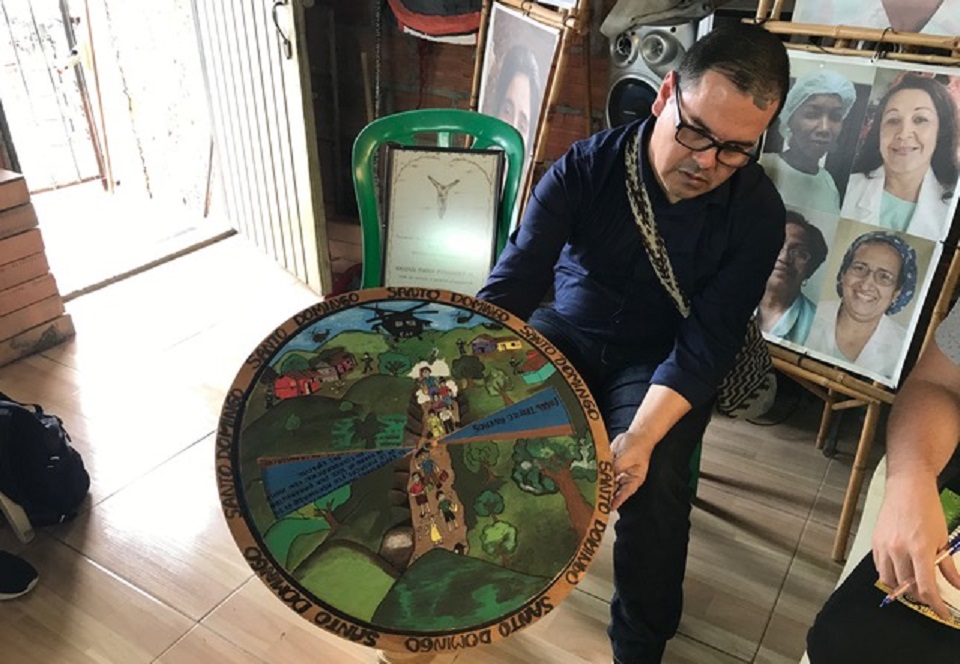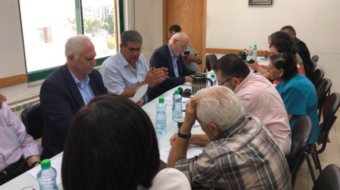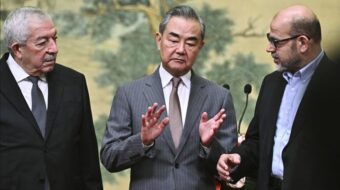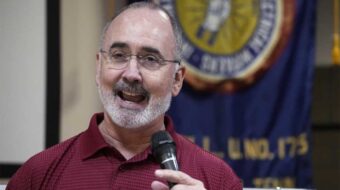
This is the first in a three-part series by People’s World reporter Eric Gordon, who recently returned from Colombia after touring with a Witness for Peace delegation. Part 2 can be read here.
During ten eventful days in January, a U.S. delegation made up of faith leaders, activists and educators made their way through Southwestern Colombia to deepen their analysis and build solidarity with grassroots movements calling for peace and social and environmental justice led by Indigenous, Afro-Colombian and peasant (campesino) communities.
The delegation, comprising members from North Carolina, Illinois and California, was able to hear first-hand about the persecution of land defenders and community leaders for their work in defense of their collective territory, protection of the environment and the preservation of their ancestral cultures. Delegates also witnessed the incredible acts of resistance amidst ongoing physical and economic violence sponsored directly and indirectly by the U.S. government and multinational corporations.
These communities resist by creating paths toward food sovereignty, collective memory and autonomous self-protection mechanisms, such as the Indigenous, Maroon and Campesina guard. Throughout the more than week-long delegation, a common demand emerged from the communities, that the “Total Peace” policy be supported by the international community, as well as full implementation of the 2016 peace accords, including the ethnic chapter, and for the U.S. government to stop financing endless war and territorial disposition of Black, campesino and Indigenous peoples.
Witness for Peace, founded 40 years ago in 1983, is a politically independent organization dedicated to nonviolence which builds transnational grassroots solidarity to resist U.S. government and corporate policies that contribute to violence, poverty and oppression in the Americas. Its delegations take U.S.-based activists through an immersive and collectively transformative process with its local partners in Latin America and the Caribbean. Current delegations go to Colombia, Honduras and Cuba.

Even the merest glance at a map of Colombia will show that this country at the northwest corner of South America is rich and variegated in terms of land, topography, altitude. The Andes mountain range extends all the way to its north, and tributaries to the Amazon occupy the whole eastern half of the country. The equator crosses Colombia just east of the neighboring country of Ecuador. Colombia’s other neighbors include Peru, Brazil, Venezuela and Panama. It has extensive coastlines on both the Pacific Ocean and the Caribbean. With such a diverse variety of climate zones, Colombia can grow almost anything.
Our delegation was based entirely in two departments (comparable to states) in the Southwest of the country, both named for the river that passes through them: Cauca and Valle del Cauca. The major city in the region is Cali, the third-largest in Colombia. The department of Cauca is tri-ethnic and rural, equally divided in population and territory among peasants (28% ), Afro-Colombians (26%), Indigenous (24%), and urban mestizos (22%). Cauca has historically been one of the Colombian regions most affected by clashes between different armed groups fighting for the territory’s control. Its geographic location in the central mountain range, its connection with the Pacific, and its proximity to the cities of Cali and Buenaventura in Valle del Cauca allows armed groups to establish transit zones, strategically locate illicit crops, and obtain resources from communities through social control. Cauca has one of the Colombia’s highest rates of inequality in land distribution and land concentration, which is at the root of the structural violence suffered by its Indigenous, Black and campesino communities.
The land is fertile and productive, but the critical issue here is land tenure. Who owns it, who occupies it, who controls it, who is dispossessed of it?
Until 2022, Colombia had been governed by a succession of parties either more or less “liberal” or “conservative,” but all of them creatures of the country’s privileged, latifundia-owning elite classes. For two hundred years, ever since the issuance of the Monroe Doctrine, the U.S. has demanded imperial hegemony over the Western Hemisphere, supplanting the previous major colonial powers of Britain, France, Spain and Portugal. Latin America has been Washington’s “back yard” for as long as the Latin American nations have been independent. Colombian governments were the recipients of the largest U.S. military “aid” package in the world—aside from Israel—and the infamous Plan Colombia was the vehicle by which Washington imposed its neoliberal, extractive, anti-labor, anti-minority, pro-corporate program, violent when need be, to keep the country dependent and submissive.
A big part of Plan Colombia involved the U.S. “war on drugs.” The Americans promoted chemical spraying of smallholder coca and marijuana fields and the theory of crop substitution. But this was bound to fail if growers were encouraged to produce commercial coffee, bananas or papayas on industrial-size plantations, with a far smaller rate of return on their work and investment and turning the peasantry into a rural proletariat. Furthermore, the Plan did not take into consideration the native, natural uses of such plants that could well be part of a healthful pharmaceutical formulary, including for export without the psychoactive ingredients. In short, under the catch-all rubric “war on drugs,” Plan Colombia was designed to destroy labor unions, ruin the rural peasant economy, reinforce American corporate extractive policies, turn Colombia into a South American and Caribbean military arm of imperialism, and force Indigenous and Afro-Colombian peoples off their historic lands.
The role of militant guerrilla forces is too complicated to review here. Suffice it to say that in the absence of a peaceful road to political power, certain groups of Colombians, inspired by Che Guevara, Mao Zedong, and/or by the teaching of liberation theology, adopted the strategy of armed revolution, and some came to dominate certain rural areas. Other groups were formed by the drug cartels that wanted to protect their control over local production, transportation across Colombia and export. At times, some of these interests overlapped. And then there are the extreme right-wing paramilitary groups, almost all of them funded by the government, in areas where the overt presence of uniformed troops was inadvisable, or by industrial associations to keep local populations, especially labor, in a state of terror.
The 2016 Peace Accord
Against this background the importance of the 2016 Peace Accord, worked out among the government and revolutionary forces with the help of Cuba and Norway, was a major landmark achievement that cannot be underestimated. For one thing, it included the dissolution of one of the main guerrilla groups, the Revolutionary Armed Forces of Colombia (FARC), and its transformation into a political party.
The Peace Accord Points comprised six main issues: 1) integral rural reform, 2) political participation and democracy, 3) end of the conflict, 4) solution to the illicit drug program, 5) recognition of victims, justice, reparation and non-repetition, and 6) implementation.
For our purposes, point no. 1 is the most critical: land reform. This section of the Accord is based on four pillars: a) access to and use of land, b) special development programs with a territorial approach, c) national development plans for the entire rural world, and d) food and nutritional security.
Subsection (a) contemplates the breakup or selloff of large latifundias—which, after all, were stolen from Native peoples in the first place! (b) reinforces the communal, as opposed to the privatistic approach toward land holding: An Indigenous people, or a community of Afro-Colombians, with their own cultural, spiritual traditions and notions about collective ownership of the land, can be granted irrevocable sovereignty. In this regard, it is important to understand that only as recently as the new Colombian Constitution of 1991 were the 115 different Indigenous nations and the Afro-Colombian peoples formally recognized as citizens—and the greatest part of the Indigenous and Afro-Colombian resistance movements has been based in the Cauca area. Africans were imported into Colombia during colonial times as slaves to work in mines and sugarcane fields: Their descendants today make their numbers the third-largest Black population in Latin America.
Subsection (c) envisions a new Colombia meant to serve both national needs and the demand of the global market; and (d) assures that if whole rural workforces are dedicated to plantation monoculture, for example, their own nutritional security will not be neglected.
The 2022 election
U.S.-compliant Colombian Presidents Álvaro Uribe (2002-2010), Juan Manuel Santos (2010-2018), and Iván Duque (2018-2022) were never enthusiastic supporters of the peace process. Quite to the contrary, they tried to undermine it at every turn. Under their administrations the killings, disappearances, and communal displacements continued on uninterrupted. On June 29, 2022, in the wake of the 2016 Accords, Senator Gustavo Petro, a former mayor of Bogotá and a veteran of a now disbanded left-wing guerrilla group, won on a campaign called the Pacto Histórico, a new coalition of left-wing and Indigenous activist groups all dedicated to implementing the Peace Accord, against Rodolfo Hernández, a former mayor of Bucaramanga. Petro won with 50.42% of the vote, over Hernández’s 47.35%.
Petro was the first person of the left elected to Colombia’s presidency. His running mate was Francia Márquez, the first Afro-Colombian elected to the vice-presidency (and the second female vice president ever), who is from Cauca and who became well known for her efforts in human rights and the environment. She has been under threat of assassination numerous times, starting with her work among gold miners in Cauca. Now for the first time, besides the immense symbolism of these left and Afro-Colombian wins for Total Peace, the terms of the Peace Accord had strong presidential authority. Any Colombian seeking relief from the assassinations, the violence, the disappearances and kidnappings, the vast injustice across the land, could now breathe more easily with hope in their hearts. They were inaugurated on August 7, 2022.
Implementation?
As any reader might surmise, getting elected and being able to implement the Total Peace program are two separate things. The disconnect became clear to our Witness for Peace delegation on our first two visits to partner organizations. One of the main problems is that Colombia’s ruling class had long devised a system of governance almost impermeable to change. As in the U.S. (which has its own protections against change), the president has limited powers. He is able to select cabinet positions and department heads in the executive branch, but the judicial branch works differently. The attorney general is elected by the Colombian Supreme Court for a period of four years. Current Attorney General Francisco Barbosa‘s term ends in 2024, so there’s still plenty of time for him to obstruct the president’s intentions.
Our first visit was in Cali, our gathering point, on the third floor of an unassumingly modest residential building in a poor neighborhood. Our destination was the Fundación Guagua, or the Memory Gallery, founded in the year 2000 as a central location to gather documentation of killings by paramilitary groups and state actors, to keep the historical memory of the victims alive, and to educate the public. It is important for the Gallery to receive international visitors, especially from the U.S., which bears so much responsibility for Colombia’s crimes. Our host was John Freddy Caicedo Álvarez, joined by his sister Delia Caicedo Álvarez and a coworker Hugo Estéban Bermúdez Pachongo.

The walls are covered by inspirational posters and artwork. I was immediately struck by seeing a poster featuring the distinctive logo SCL, which I recognized as that of the Southern California Library in my hometown of Los Angeles. It read, “Though a mind may not be able to dismantle stone walls, it can dismantle a state that erects the walls,” a quote from John Edgar Wideman’s Brothers and Keepers. Clearly I was not the first international visitor from L.A.
Freddy talked at length about the case of Father Tiberio A. Fernández, a country priest from the town of Trujillo who was active in the movement to form peasant cooperatives. Padre Tiberio drove to the next town to give last rites to a friend of his who had been murdered and who was then tortured and killed himself, his body cut up with a chainsaw and the remains dumped in the Trujillo river.
In some cases, where paramilitary men are found, or confess to have committed such crimes, they are easily either declared “crazy” or extradited to the U.S. on “drug-trafficking” charges, serve a short sentence, and are then released to live out the rest of their lives in comfort thanks to U.S. taxpayers.
Another focus of the Gallery is to record the history of the “Paro,” the national strike that broke out in Cali in 2021 that quickly united a large swath of local groups into a movement that spread throughout Colombia. An estimated 60 people were killed or disappeared during that time until it eventually died down. The results of the Paro were not felt immediately, Freddy told us, but it had a longterm effect on the idea of people’s power as an alternative to the elite which had no humane solution to the country’s problems. That new consciousness went into the 2022 electoral struggle that brought Petro and Márquez into office. Francia Márquez is from this area and many people know her.
One of the teaching tools the Gallery has developed are its “memory circles.” They have constructed portable shrines, as it were, to the victims of given massacres, with painted scenes from the incident on the top circle, which has two cutouts, like pizza slices. On the second circular panel behind the painting, names of the victims appear with, in the other cutout, brief information about their lives. In this way these once-anonymous individuals take on personality and identity and are remembered.

“From the tree of memory against forgetfulness and impunity,” their motto reads, “we gather our seeds of truth, justice and reparation.” Anything short of that, they say, will replicate violence of the past. All of their objectives will not be fulfilled overnight, and many will be thwarted by the bureaucracy.
La Elvira
Another instance of administrative sclerosis came to light later that same day. We visited La Elvira farm, a 100-acre peasant (campesino) collective in the town of Miranda where 25 families live. Out of their own experience, and with the help of experts from local universities, they have started a Campesino University for Miranda and Northern Cauca. They are trying to turn the beautiful words of the Colombian Constitution into the lived reality of a community dedicated to peace. Some of those living here are ex-combatants learning new skills and adopting a stable way of life. After the government initially helped acquire the land, it then abandoned the community.

Among its challenges is emerging out of monoculture focusing on cattle and sugarcane and diversifying into fish farming, pigs, poultry and vegetables for local consumption, not for export. Another challenge is fighting back against the “green revolution,” the imposition of GMO seeds from Monsanto and other agribusiness monopolies as part of North American neoliberalism, and reestablishing traditional crops and farming methods in the process of recovering the land.
Among the traditional crops are both coca and marijuana, which they transform into effective pomades, ointments, vaporubs. They try to resist the pressure to grow these products for export, which only strengthens the hand of the drug cartels. But time is short: Even dysfunctional as the wheels and cogs of government are, Petro and Márquez are only in office for four years, and who knows what will follow them?
One of the qualities of the group meeting we attended to meet the residents of La Elvira that stood out was the self-confidence and articulateness of ordinary people convinced they are doing great, important work. As each introduced themselves, one could hear their pride as they recited both their name and the leadership office they held, however humble. Their survival itself is a vital form of resistance, though constant death threats remind them of the forces still around that would restore the state of terror and war. Each community has developed its own (unarmed) protective force, but they cannot be everywhere at once, so people in leadership positions have to take special measures when they travel beyond the confines of farm and collective.

Sara Klinger, a young woman who helps the community from her base in Popayán, the capital of Cauca farther to the south, identified herself as a member of the Communist Youth. She cited another example of the inability of the new executives in government to operate effectively. Two weeks before the election last summer, the government arrested a number of young people who were agitating to get out the youth vote. Communist youths Andrés Duque and Bremmen Hinestroza, both of them 30, artists, students and parents, have been in jail ever since, even though they have been deemed no threat to society. They are on the presidential decree of people to be freed, but the courts need to approve it and so far have not. In one similar case, a judge released two other prisoners, and now the judge herself is under investigation. Those who previously held the upper hand are actively trying to recapture their rule.
In the next installments of my Colombian “witness” we’ll look in greater depth at some of the other communities we visited.












Comments